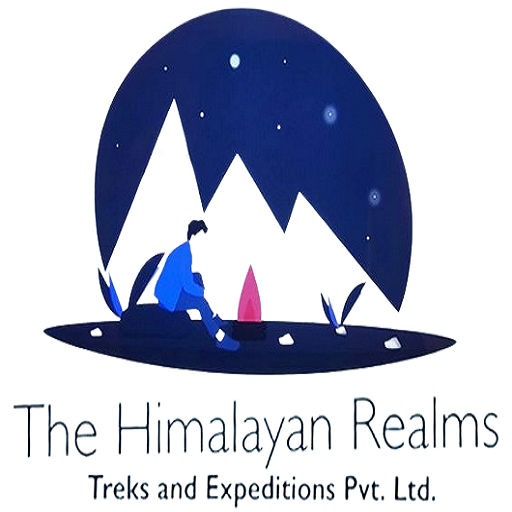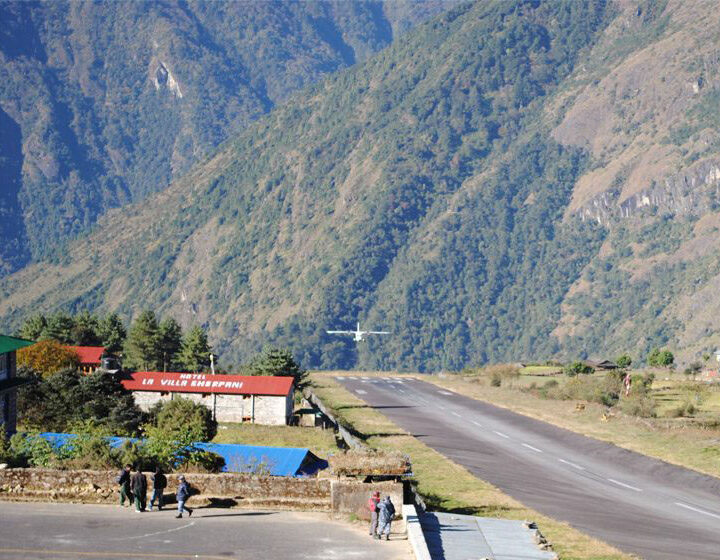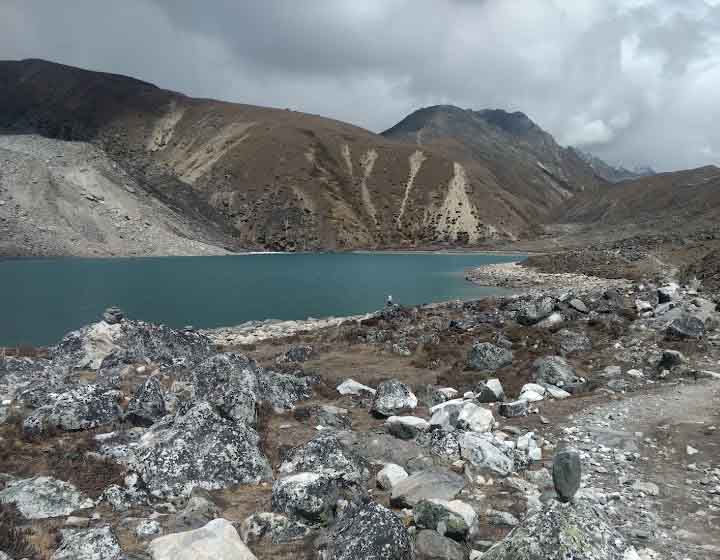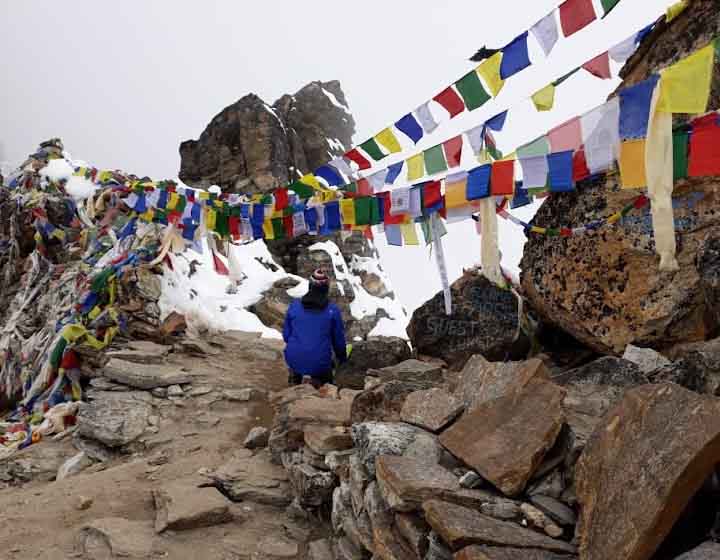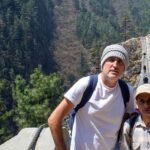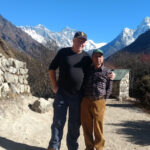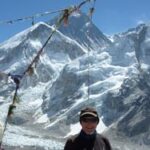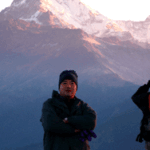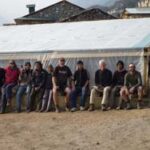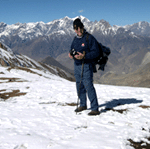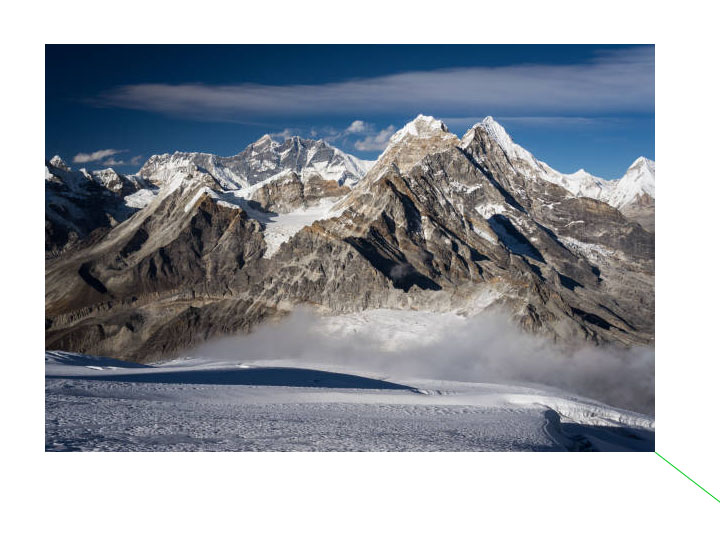
Trip overview
Mera Peak Treking & Climb is one of the most impressive trekking peaks and holds as the highest trekking peak among other over 6,000 meters. Mera Peak Trekking & Climb leads into absolute isolation and in wilderness with natural surroundings away from villages and human settlements, this is truly a remarkable adventure into the wildest area of Hinku valley in eastern Khumbu region, located just southeast from the giant world highest Mt. Everest offering amazing scenery of beautiful landscapes, hills, and valleys with snow-capped mountains.
Mera Peak is great for both trekking and climbing. Standing at 6,461 meters, it is Nepal’s highest trekking mountain, classified as PD (Peu Difficile) on the Swiss/French Alpine System. Although it has less technical difficulties than other peaks, climbers must negotiate glaciers, making it a more challenging ascent. The path to Mera Peak follows the glacier trail and the hidden Hinku Gorge, providing a breathtaking experience in a remote and less-traveled area of the Khumbu and Everest regions. “The Hinku Gorge is rich in diverse vegetation and wildlife, featuring magnificent forests of magnolia, rhododendron, birch, and pine trees. The ascent officially begins at Mera High Camp (5,780m); ‘Because of’ before making the final summit push, all climbers take time to rest and acclimatize at Mera Base Camp (5,300m).
Although the summit is achievable for many, it presents a greater technical challenge compared to other trekking and climbing peaks in Nepal.” Our skilled climbing guides assure safety by fastening ropes and building solid routes as needed. When climbers reach the summit of Mera Peak, they are rewarded with an incredible view of the Himalayas, which includes Mt. Everest, Lhotse, Makalu, and even Mt. Kanchenjunga in the far east.
Mera peak trekking is magnificent adventure begins and ends with a sweeping scenic short flight to and from Lukla town, the gateway to Everest and to other wonderful area of Khumbu, walk leads through high passes, tranquil forest, summer pasture, and towards moraines and glacial lakes after an adventurous climb to Mera Peak, return journey on the same route back to Lukla, from here concluding this awesome adventure with scenic short flight back to Kathmandu, after completing this fascinating journey to Mera Peak trek and climb with Unique Holidays excellent services and caring.
Lifestyle and Culture
The Sherpa people live in the Mera Peak region and are recognized for their resilience, friendly hospitality, and Buddhist traditions. The journey will take you through traditional Sherpa communities with stone dwellings and prayer flags.
Ancient Buddhist monasteries, chortens, and mani walls.
Locals live a basic existence based on yak herding and agriculture.
The spiritual rituals and festivals reflect the influence of Tibetan Buddhism.
Vegetation and atmosphere
The walk starts at Lukla (2,860m) and passes through beautiful woods before entering alpine and glacial scenery.
Vegetation Zones:
Lowland Forests (1,500m – 3,000m) Found in the Khumbu and Hinku Valley regions. Dominated by rhododendron, pine, fir, birch, and juniper forests. Lush greenery, especially during spring when rhododendrons bloom (March-May). Rich biodiversity, home to animals like Himalayan tahr, musk deer, and various bird species.
Sub-Alpine Zone (3,000m – 4,000m)
Transitioning to dwarf rhododendron, juniper, and bamboo shrubs. Trees start thinning out, and vegetation becomes sparser. The terrain includes meadows and yak pastures.
Alpine Zone (4,000m – 5,000m)
Vegetation is minimal, with mosses, lichens, and small shrubs. The landscape turns rocky with patches of grasslands used for yak grazing. Hardy plant species adapted to extreme cold and wind.
Glacial and Snowline Zone (5,000m – 6,476m) Above 5,000m, vegetation is almost nonexistent. Terrain is dominated by glaciers, moraines, and barren rocks. Only microscopic plant life like algae and lichens survive in these harsh conditions.
Atmosphere and Climate:
Rhododendrons are flowering. Autumn (September–November): Stable weather with clear skies and ideal peak conditions. Winter (December-February) brings harsh cold, significant snowfall, and strong winds.
Summer/Monsoon (June-August): Rainy season with low visibility and a high avalanche risk.
Short Itinerary
Day 1: Arrival in Kathmandu (1,350m), trek preparation.
Day 2: Fly to Lukla (2,860m) & trek to Paiya (2,730m).
Day 3: Trek to Panggom (2,846m).
Day 4: Trek to Ningsow (2,863m).
Day 5: Trek to Chhatra Khola (3,150m).
Day 6: Trek to Kothe (3,600m).
Day 7: Trek to Thaknak (4,350m).
Day 8: Trek to Khare (5,045m) – Acclimatization Day.
Day 9: Climb to Mera Base Camp (5,300m).
Day 10: Trek to High Camp (5,780m).
Day 11: Summit Mera Peak (6,476m) & return to Khare.
Day 12: Trek to Kothe.
Day 13: Trek to Thuli Kharka (4,300m).
Day 14: Trek to Lukla & fly back to Kathmandu.
Itinerary
We can catch an early morning flight from Kathmandu to Lukla and begin our trek to Paiya after landing at the Tenzing-Hillary airport in Lukla. We walk on a jungle trail, cross a bridge over the Handi Khola and reach Surke Village. From here we continue moving south and cross the Chutok La pass before reaching the small settlement of Paiyan, also known as Chutok. Stay overnight Paiya.
Day 04: Paiya to Panggom (2,846m/9,337ft): 5-6 hours:-We descend for a while and reach a small bridge. From here the trail is slippery until we cross the Kari La pass. We walk through rhododendron and bamboo forests on a narrow mountain trail. On today’s trip we also get to be in awe of the Dudhkoshi Valley. We continue our trek to Panggom Village whose settlers are dependent on farming and trading. Stay overnight in Panggom.
Panggom to Ningsow (2,863m/9,393ft): 4-5 hours:-We begin our trek after breakfast. After trekking out of Panggom, we cross the Panggom La pass. Then we ascend, walk on a steady path and turn north. We cross Peseng Kharka Khola first then after walking for some time, reach Peeng Kharka Danda. We cross Ningsow Khola (stream) before reaching the Ningsow Village. Stay overnight in Ningsow.
From Ningsow, we climb first then descend for a while and climb some more to reach Ramailo Danda. From here we get extraordinary views of Mera Peak and Salpa. After ascending and descending on our trail, we enter the Makalu Barun National Park. Our trail from here to Chhatra Khola is called Pasang Lhamu trail. On the way, if we are lucky, we might even come across the elusive Red Panda. Stay overnight in Chhatra Khola.
Chhatra Khola to Kothe (3,691m/12,109ft): 6-7 hours:-We walk towards the north on the main trail to Mera Peak. After walking on a trail next to the the Majang Khola, we merge with another trail which moves alongside the Hinku Khola. Our trail moves straight ahead towards Tashing Ongma which has seasonal tea shops. We continue our trek and cross the bridge over the Sanu Khola before us reaching Kothe. Stay overnight in Kothe.
Kothe to Thaknak (4,358m/14,297ft): 3-4 hours:-We trek along the ridge of the Hinku Khola in the shadow of Mera Peak. We take lunch at Gondishung, the summer herders’ settlement in the west bank of the Hinku Drangka. Beyond Gondishung, we pass a 200-year-old Lungsumgba Gompa where we can find Mera Peak scripted in rock along with its route to reach Mera. A short walk takes us to Thaknak, which is a summer grazing area with primitive lodges and shops. Stay overnight in Thaknak.
Thaknak to Khare (5,045m/16,486ft): 2-3 hours:-Leaving Thaknak, we follow the lateral moraine of Dig Glacier to Dig Kharka, which offers spectacular views of Charpate Himal. The trail climbs through moraines to the snout of the Hinku Nup and Shar glaciers, and then climbs more steeply to Khare. From here, we can see the northern face of Mera Peak which will be an amazing experience. After lunch we can hike in and around Khare. Stay overnight at Khare.
Khare: Acclimatization and pre–climb training:-We have a separate day set aside solely for acclimatization and basic training just to prepare ourselves better for the Mera Peak climb. Our climbing leader will help us polish our basic climbing techniques and demonstrate the best ways to use our climbing gears like the ice axe, harness, ascender climbing boots and crampons. The training will also include learning the best climbing technique with the rope. Stay overnight in Khare.
Khare to Mera High Camp (5,780m/18,958ft): 6-7 hours:-We walk through a boulder-strewn course on a steep trail to reach the Mera Peak Base Camp. From here, we continue further through the Mera La pass to reach the Mera High Camp. Our path is along a rocky trail, which can be hazardous if it has recently snowed, as there are a number of crevasses here. We make our way to the top of the rock band, which is marked by a large cairn. Then we set up a high camp while enjoying excellent views of Mt. Everest, Makalu, Cho Oyu, the south face of Lhotse, Nuptse, Chamlang and Baruntset Mera High Stay overnight at Camp in the camp.
This is a really important day for the expedition. We wake up around 2 in the morning for breakfast. It’s going to be very cold in the beginning but soon we warm up as we continue up the glacier and onto a peculiar ridge. The first rays of the sun hit the big peaks in an amazing red glow. The route is still non-technical as we slowly climb higher into the ever-thinning air. The slope steepens for a section behind the ridge and the summit comes back into view. At the foot of the final steep summit cone, we may use a fixed rope if the climbing leader believes it’s required. The summit is only a few meters away. From the summit, we take in spectacular views of the mighty Himalayas including Mt. Everest (8,848m), Cho-Oyu (8,210m), Lhotse (8,516m), Makalu (8,463m), Kangchenjunga (8,586m), Nuptse (7,855m), Chamlang (7,319m), Baruntse (7 ,129m) and others. Later, we retrace our steps back to the high camp where we rest for a while before descending to Khare. Stay overnight in Khare.
Reserve Day for Contingency:-There is no guarantee that we will have favorable weather on our planned day for the summit. Therefore, this day is set aside as a contingency in case we are unable to summit the Mera on the desired day due to bad weather conditions or any other unanticipated reason. However, if the trip goes smoothly, this day will not be required.
Khare to Kothe (3600m/11808ft): 4-5 hours:-We trek from Khare to Kothe along the same trail used previously. After reaching Kothe, we celebrate our success by trying out local delicacies and wines. Stay overnight in Kothe.
Day 15: Kothe to Thuli Kharka (4,300 m/14,107ft): 5-6 hours:-We begin our trek to Thuli Kharka after breakfast. We climb up and descend, cross several tributaries of the Inkhu Khola before reaching a forked trail nearby Taktho. We choose the trail on our right and continue walking. Our trail passes by a Chorten after which we walk downhill on a steep trail. Next, we ascend to Thuli Kharka and pass by another Chorten on the way. Stay overnight in Thuli Kharka.
Thuli Kharla to Lukla via Zatrwa La pass: 6-7 hours:-We cross the Zatrwa-La pass at 4,600. As soon as we cross the pass, we are welcomed by the sight of the beautiful Lukla Valley which is surrounded by Cho Oyu, Kongde Peak, Numbur Himal, Kusum Khangru and other Himalayan peaks. From Zatrwa La pass we walk all the way down to Chutang and then straight forward to the Lukla village. In the evening we enjoy dinner in the Himalayas of Nepal with our crew. Stay overnight in Lukla.
Fly to Kathmandu:-We catch an early morning flight to Kathmandu. After reaching Kathmandu, we can take a rest or do some souvenir shopping. If we want to explore any other areas of Kathmandu, we may do that today. Our guides can help you with both souvenirs shopping or sightseeing. There will be a farewell dinner in the evening to celebrate the climbers’ successful summit of the Mera Peak. Stay overnight in Kathmandu.
Final departure transfer from Hotel to international airport
Included
- All airport, hotel airport transfers
- 2 night accommodation in Kathmandu with B/B basic plan
- Round trips flight ticket for Gudest , guide and some staff.
- National Park permit
- Mera peak climbing permit.
- Khumbu village parmit
- Garbage deposit charge
- Accommodation in the tea house,food, Tea/coffee during trek
- Guide:- including salary, insurance, equipment, flight, food and lodging
- Climbing guide charge and equipment fees.
- Porter:- including salary, insurance, equipment, food and lodging
- For guest:-Down jacket, Good sleeping bag (down jacket and sleeping bag are to be returned after trip completion)
- All government and local taxes
Not Included
- Food in Kathmandu ( Lunch & Dinner)
- Bakery food during the trek
- Nepal Visa fee
- International airfare from your country to Kathmandu and from Kathmandu
- Extra night accommodation in Kathmandu
- Travel and rescue insurance if guest get mountain sickness and need to rescue helicopter.
- Personal expenses example (phone calls, laundry service , bar bills, battery recharge, extra porters, bottle or boiled water, shower etc)
- Tips for guide and porters
Useful Info
Duration: 14 days
Max Elevation: 6,476m (Mera Peak summit)
Grade: Strenuous
Trek Type: Teahouse + Camping at high altitudes
Best Seasons: Spring (March-May) & Autumn (September-November)
Permit Required: NMA Climbing Permit, Makalu Barun National Park Entry Permit, and Khumbu Pasang Lhamu Rural Municipality Permit
Physical Fitness: Requires high endurance and prior trekking experience above 4,000m.
Technical Skills: Basic ice axe & crampon skills, but no prior mountaineering experience needed.
Acclimatization: Essential due to high altitude—spend extra days for adaptation.
Equipment Checklist
Clothing: Down jacket, thermal layers, waterproof shell, gloves, and gaiters
Climbing Gear: Ice axe, crampons, harness, helmet, jumar, and ropes
Footwear: High-altitude mountaineering boots
Sleeping Bag: -20°C rating recommended
Best Time to Trek Spring (March-May): Stable weather, clear skies, and warmer temperatures
Autumn (Sept-Nov): Best visibility and moderate weather
Accommodation & Meals
Teahouse Lodges in lower areas (Paiya to Khare)
Camping at High Camp
Meals: Dal Bhat, noodles, soups, tea, and high-altitude diet
